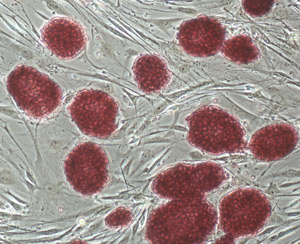
Fig. 1: An image of iPS cells (red) generated from mouse fibroblast cells using Nr5a2 in place of Oct-4.
Reproduced, with permission, from Ref. 1 © 2010 Elsevier
Molecular biologists from A*STAR’s Genome Institute of Singapore have discovered a transcription factor that can not only substitute for the previously indispensible compound Oct-4 in the generation of induced pluripotent stem (iPS) cells, but can also enhance the efficiency of the reprogramming process.
Oct-4, along with Sox-2, Klf-4 and c-Myc, are the four transcription factors typically used to reprogram specialized adult cells into generalized stem cells. Until this discovery, however, Oct-4 was the only one considered irreplaceable.
“We need to identify … different ways to generate iPS cells, and the roles of these molecules in reprogramming,” says Huck-Hui Ng, who led the research group. “Once we have a detailed understanding, the generation of iPS cells will become more efficient.”
In work detailed in Cell Stem Cell, Ng and his co-workers started by testing 19 members of a particular group of transcription factors known as nuclear receptors to see if any could increase the efficiency of reprogramming with a typical cocktail of Oct-4, Sox-2, Klf-4 and c-Myc. They found two that did: Nr5a2 and Nr1i2. In fact, Nr5a2 increased efficiency fourfold, and also hastened the process.
The researchers then looked at whether any of the nuclear receptors could replace one or other of the traditional reprogramming compounds. Much to their surprise, they discovered Nr5a2 could substitute for Oct-4 in mouse cells (Fig. 1). The resulting iPS cells produced fertile, live-born mouse chimeras—individuals that are derived from a mixture of iPS and natural embryonic cells. The researchers also found that the closely related compound Nr5a1 behaved in a similar manner, but was not as efficient.
Like other transcription factors, nuclear receptors bind directly to a specific sequence of DNA, and this, the researchers found, was an important component in the activity of Nr5a2. They also showed that Nr5a2 interacts with many of the same genes as Sox-2 and Klf-4. This suggests that these three transcription factors work in concert to control the reprogramming process.
When the researchers stabilized Nr5a2 to increase its ability to activate transcription, they found it enhanced its reprogramming efficiency even further.
“The most significant part of this work is being able to show that there are alternative ways to generate iPS cells,” says Ng. “We have now demonstrated that Oct-4’s function in initiating reprogramming can be replaced by other non-related transcription factors. We are continuing to search for new reprogramming factors.”
The A*STAR-affiliated authors in this highlight are from the Genome Institute of Singapore.



